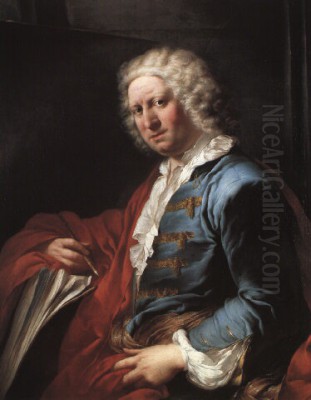
Giovanni Paolo Panini stands as one of the most significant painters of 18th-century Italy, an artist whose name became synonymous with breathtaking views of Rome. Born in Piacenza on June 17, 1691, and passing away in Rome on October 21, 1765, Panini's career unfolded primarily in the Eternal City, which he captured with unparalleled skill and affection. He was not only a painter but also a talented architect and designer, mastering the art of perspective to create both accurate depictions of the city (vedute) and imaginative architectural fantasies (capricci). His work provides an invaluable visual record of Rome during a period of intense international interest, particularly from Grand Tour travelers seeking souvenirs of their journeys.
Formative Years in Piacenza
Panini's artistic journey began in his hometown of Piacenza. As a young man, he immersed himself in the fundamentals of painting and design. His early training focused significantly on perspective and architectural representation, skills that would become hallmarks of his mature style. He studied under local painters such as Giuseppe Natali and Andrea Galluzzi, who likely grounded him in the techniques of quadrature painting – the illusionistic depiction of architecture on ceilings and walls.
Crucially, Panini also gained experience in stage design, possibly studying with or being heavily influenced by a member of the renowned Galli-Bibiena family, specifically Francesco Galli-Bibiena. This family dominated theatrical design across Europe, known for their elaborate perspectives and dramatic spatial illusions (scena per angolo, or angled perspective). This background in scenography instilled in Panini a deep understanding of how to manipulate space visually and create compelling, immersive environments, a skill he would later translate from the stage to the canvas and palace walls.
Arrival and Establishment in Rome
In 1711, seeking broader opportunities and exposure to the heart of the classical and Baroque worlds, Panini moved to Rome. The city was a magnet for artists from across Europe, drawn by its ancient ruins, Renaissance and Baroque masterpieces, and the patronage opportunities offered by the Church and aristocracy. Panini continued his studies, notably associating himself with the Accademia di San Luca, Rome's premier artistic institution, where he would later become a prominent member and even its principal.
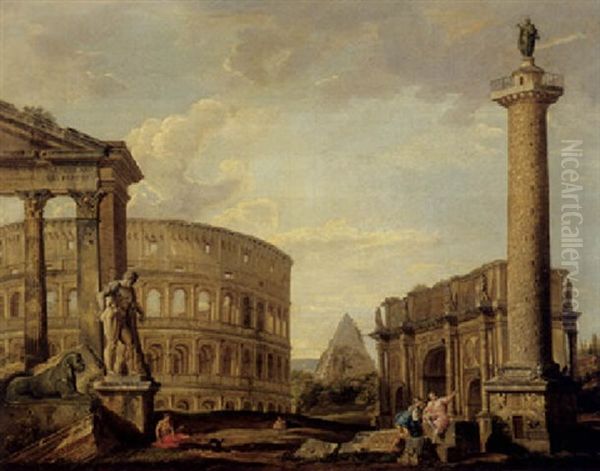
He quickly established himself as a skilled decorative artist. His training in perspective and architectural illusionism made him highly sought after for decorating the interiors of Roman palaces and villas. Early commissions included work at the Villa Patrizi (around 1719-1725), the Palazzo Carpegna (now part of the Accademia di San Luca), and the Seminario Romano. These projects often involved creating complex frescoes that seemed to extend the real architecture of the room into painted space, showcasing his mastery of trompe l'oeil techniques learned partly from his stage design background. He entered a vibrant artistic milieu, contemporary with figures like the sculptor Camillo Rusconi and painters such as Sebastiano Conca.
Rome Through Panini's Eyes: The Vedute
While decorative work provided income and reputation, Panini's lasting fame rests on his easel paintings, particularly his vedute, or view paintings. The veduta genre, popular throughout the 18th century, involved detailed, often large-scale depictions of cityscapes or landscapes. While Venice had masters like Canaletto and Bernardo Bellotto, Panini became the preeminent vedutista of Rome. His work in this area built upon the foundations laid by earlier view painters active in Rome, such as the Flemish-born Gaspar van Wittel, known in Italy as Vanvitelli.
Panini painted virtually every famous landmark of Rome, both ancient and modern. His canvases frequently feature the Colosseum, the Roman Forum, the Pantheon, Trajan's Column, the Arch of Constantine, St. Peter's Basilica and Square, Piazza Navona, and the Trevi Fountain. These views were highly prized by foreign visitors on the Grand Tour, serving as sophisticated souvenirs of their cultural pilgrimage. Panini's vedute are characterized by their topographical accuracy, careful rendering of architectural detail, luminous atmosphere, and skillful handling of perspective, often employing wide-angle views to encompass grand vistas.
However, Panini's views were rarely simple photographic records. He often subtly adjusted perspectives, lighting, and the placement of elements for greater compositional harmony and dramatic effect. His scenes are invariably populated by small, lively figures (staffage) – aristocrats, tourists, artists sketching, merchants, common folk – which add scale, narrative interest, and a sense of contemporary life unfolding amidst the monumental backdrop of history. These figures, sometimes painted with the help of specialist collaborators, animate his meticulously rendered architectural settings.
Imaginary Realms: The Art of the Capriccio
Alongside his relatively faithful vedute, Panini excelled in the genre of the capriccio. A capriccio, in this context, is an architectural fantasy. Panini would take real Roman monuments, ruins, and sculptures and rearrange them in imaginative, often impossible, combinations within a single composition. These works allowed him greater creative freedom, enabling him to evoke the spirit and grandeur of ancient Rome rather than documenting a specific location.

His capricci often feature picturesque arrangements of crumbling arches, classical temples, broken columns, sarcophagi, and famous statues, set in idealized landscapes under dramatic skies. These paintings appealed strongly to the era's burgeoning interest in antiquity and the romantic sensibility associated with ruins. They served not just as souvenirs but also as decorative pieces that could evoke the classical past within the homes of collectors. Panini's capricci show an affinity with the work of earlier artists like Salvator Rosa and Marco Ricci, who also painted imaginative landscapes with ruins, but Panini brought a greater architectural precision and a lighter, more elegant Rococo sensibility to the genre.
His approach contrasts with the darker, more intensely dramatic, and often archaeologically speculative architectural fantasies found in the etchings of his slightly younger contemporary, Giovanni Battista Piranesi. While both artists were fascinated by Roman ruins, Panini's painted capricci generally offer a more serene, picturesque, and accessible vision of antiquity compared to Piranesi's sublime and often overwhelming printed images.
Masterpiece: Interior of the Pantheon
Among Panini's most celebrated works are his numerous depictions of the interior of the Pantheon, arguably the best-preserved ancient Roman building. He painted this subject multiple times from slightly different viewpoints throughout his career (e.g., versions from c. 1734 in the National Gallery of Art, Washington D.C., and others). These paintings are tours de force of perspective, capturing the immense scale and perfect geometry of the Hadrianic structure.
Panini masterfully renders the play of light streaming through the oculus, the unique opening in the center of the coffered dome, illuminating the vast cylindrical space below. He meticulously details the marble revetment, the Corinthian columns, the altars, and the classical niches. The inclusion of diverse figures – tourists gazing upwards in awe, elegantly dressed visitors conversing, artists sketching – emphasizes the building's function as both a working church (Santa Maria ad Martyres) and a monument attracting cultural pilgrims. These paintings perfectly encapsulate Panini's ability to combine architectural accuracy with atmospheric effect and human interest.
Masterpieces: The Picture Galleries
Two of Panini's most famous and ambitious works are the pendants Ancient Rome (1757) and Modern Rome (1757), now housed in the Metropolitan Museum of Art, New York (with earlier versions existing, e.g., at the Louvre). These large canvases are themselves elaborate capricci, depicting imaginary palatial galleries filled with paintings of Rome's most famous sights and sculptures.
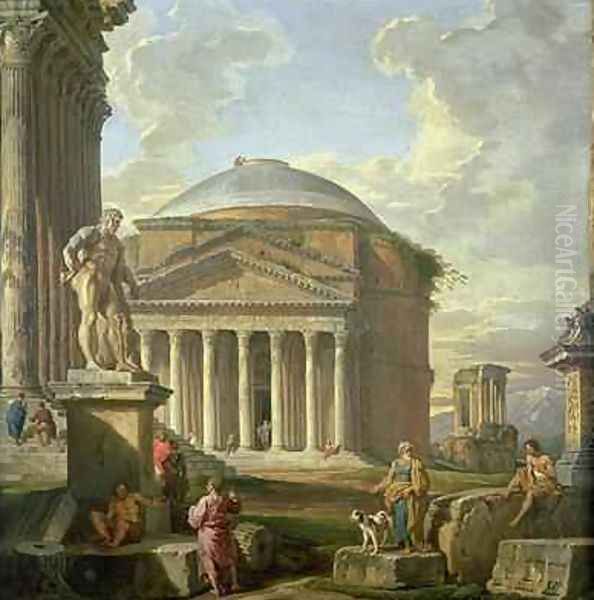
Ancient Rome shows a grand gallery whose walls are covered with Panini's own vedute of ancient Roman monuments like the Colosseum, the Pantheon, and various arches and temples. Scattered throughout the hall are miniature versions of renowned ancient sculptures, including the Laocoön, the Farnese Hercules, and the Apollo Belvedere. Modern Rome uses the same format but features paintings of contemporary Roman landmarks, primarily churches and palaces from the Renaissance and Baroque periods, such as St. Peter's Basilica, Piazza Navona, the Trevi Fountain, and paintings by renowned artists like Raphael and Guido Reni. Famous modern sculptures like Bernini's David and Apollo and Daphne are also included.
These paintings were commissioned by the French ambassador, the Duc de Choiseul, and represent the ultimate Grand Tour souvenir, encapsulating the entirety of Rome's artistic and architectural heritage within two spectacular canvases. They demonstrate Panini's encyclopedic knowledge of the city, his skill in miniature representation within the larger composition, and his understanding of the desires of his elite clientele.
Documenting Festivities and Ceremonies
Panini's role as a chronicler of Rome extended beyond static views of monuments. He was frequently commissioned to record important contemporary events, such as state visits, ambassadorial processions, papal ceremonies, and public festivals. Paintings like Departure of the Duc de Choiseul from St. Peter's Square or depictions of celebrations in Piazza Navona capture the pomp and circumstance of 18th-century Roman life.
Furthermore, his background in stage design made him adept at designing the ephemeral architecture – temporary arches, stages, and elaborate firework machines (macchine and fuochi d'artificio) – that were central to these public spectacles. His paintings of these events often meticulously record these temporary structures, providing valuable information about festival practices and design in the Baroque era. These works showcase his versatility and his engagement with the living city, not just its historical remains.
Architectural Decoration and Design
While Panini is best known for his easel paintings, his career began with, and continued to include, significant work as a decorative painter and architect. His frescoes in Roman palaces, such as the Palazzo Alberoni and the Palazzo del Quirinale (though attribution here can be complex), employed the quadratura and trompe l'oeil techniques he had mastered early on. He could create illusions of soaring architectural spaces, coffered ceilings, or views opening onto imaginary landscapes, seamlessly blending painted decoration with the real architecture of the room.
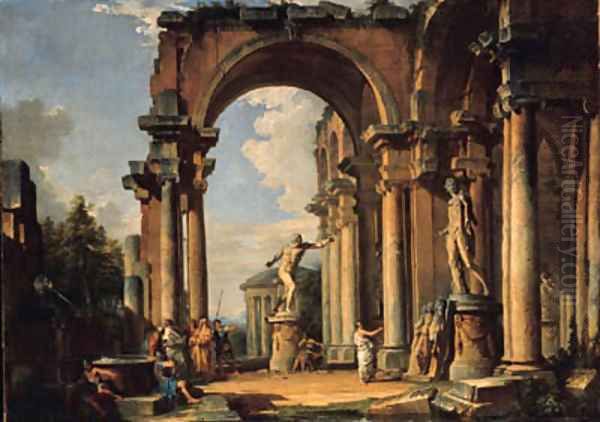
His skills were not limited to painting architecture; he also practiced as an architect. Although fewer documented examples exist compared to his paintings, his design for the Villa Patrizi demonstrates his competence in architectural composition, likely reflecting the prevailing late Baroque and early Neoclassical tastes. This practical experience with building undoubtedly informed the convincing realism of his painted architectural views. His work in this area places him within the broader context of Roman Baroque architecture, alongside figures like Alessandro Specchi and Ferdinando Fuga, who were shaping the city's fabric during his lifetime.
A Respected Teacher and Academician
Panini's stature in the Roman art world was confirmed by his active role in its leading institutions. He became a member of the prestigious Accademia di San Luca in 1718. His reputation grew steadily, and he held teaching positions within the academy. His expertise in perspective was particularly valued. In 1754-1755, he achieved the highest honor by being elected Principe (Principal or President) of the Accademia, cementing his position as a leading figure in Roman art.
He also taught perspective at the Académie de France à Rome, the French academy located in the Palazzo Mancini. This institution played a crucial role in training French artists who had won the Prix de Rome. During his tenure, he would have interacted with its directors, such as Charles-Joseph Natoire, and numerous young French painters and sculptors. His presence there facilitated the transmission of his style and techniques, particularly his approach to landscape and architectural painting, to a new generation of artists, especially those from France.
Shaping Future Generations
Panini's influence extended significantly beyond his direct students. His paintings were widely disseminated through engravings, making his compositions known throughout Europe. His particular way of seeing and representing Rome – emphasizing its picturesque qualities, monumental scale, and historical layers – profoundly shaped the visual imagination of subsequent generations.
Most notably, he had a direct impact on several French artists who spent time in Rome. Jean-Honoré Fragonard, known for his exuberant Rococo scenes, studied Panini's work and absorbed his handling of light and landscape, evident in Fragonard's drawings and paintings of Italian gardens and ruins. Perhaps even more directly influenced was Hubert Robert, who became known as "Robert des Ruines." Robert adopted Panini's subject matter of Roman ruins and capricci, often infusing them with a more pronounced romantic or melancholic sensibility that anticipated later movements. Panini's meticulous yet atmospheric style provided a crucial model for Robert and others seeking to capture the allure of antiquity.

His son, Francesco Panini (c. 1745–c. 1812), also became a painter, working in his father's style and often producing drawings and prints after his father's compositions, further helping to popularize Giovanni Paolo's work, particularly views of St. Peter's Basilica. Other contemporary painters like Antonio Joli and later artists specializing in Roman views operated within the tradition Panini had so masterfully defined.
Panini's Artistic Signature
Giovanni Paolo Panini's style is a distinctive blend of late Baroque dynamism and emerging Neoclassical clarity. His compositions are typically anchored by a sophisticated use of linear perspective, often employing one-point or two-point systems to create convincing illusions of depth and spatial recession. This mathematical underpinning, derived from his early training, provides a sense of order and structure even in his most complex views or imaginative capricci.
His handling of light is another key feature. He often used strong contrasts of light and shadow (chiaroscuro) to model architectural forms, enhance drama, and guide the viewer's eye through the composition. His atmospheres are typically bright and clear, suffused with the characteristic Roman light. His color palettes tend towards luminous earth tones, blues, and greys, accurately capturing the textures of stone, marble, and sky.
The inclusion of staffage is integral to his work. These small figures are rendered with lively detail, depicting a cross-section of Roman society and adding narrative vignettes to the scenes. While Panini was capable of painting figures himself, it's possible he sometimes collaborated with figure specialists, a common practice at the time; painters like Benedetto Luti represented the high quality of figure painting in Rome during Panini's early career, setting a standard. Overall, his technique is characterized by precise draftsmanship combined with a fluid, painterly application that avoids stiffness.
Enduring Legacy
Giovanni Paolo Panini died in Rome in 1765, leaving behind a prolific body of work and an enduring legacy. He was the undisputed master of the Roman veduta in the 18th century, creating images that defined the perception of the Eternal City for generations of Europeans. His paintings were not merely topographical records but carefully constructed works of art that captured the grandeur, history, and contemporary life of Rome.
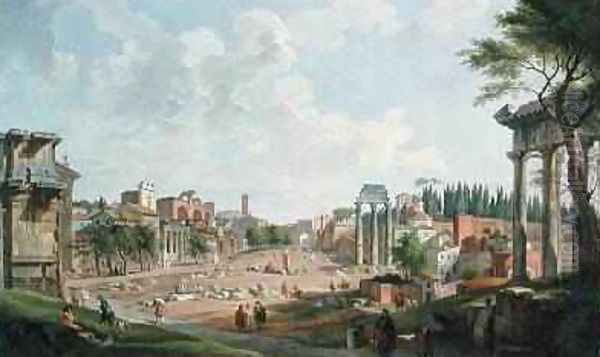
His capricci contributed significantly to the 18th-century fascination with antiquity and the picturesque, influencing landscape painting and decorative arts. His role as a teacher at both the Roman and French academies ensured the transmission of his skills and vision. Today, his works are held in major museums worldwide, including the Louvre in Paris, the Metropolitan Museum of Art in New York, the National Gallery in London, the National Gallery of Art in Washington D.C., the Prado Museum in Madrid, the State Hermitage Museum in St. Petersburg, and many others. They continue to be admired for their technical brilliance, historical value, and evocative power.
Conclusion
Giovanni Paolo Panini was more than just a painter of views; he was a visual poet of Rome. Through his meticulous vedute and imaginative capricci, he captured the complex soul of a city layered with history, faith, and vibrant contemporary life. His mastery of perspective, light, and composition allowed him to create immersive and enduring images that satisfied the demands of Grand Tour patrons while establishing him as a major figure in 18th-century European art. His legacy lies not only in the beauty of his canvases but also in the powerful vision of Rome that he bequeathed to posterity.